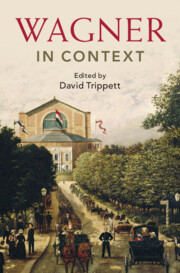Book contents
- Wagner in Context
- Composers in Context
- Wagner in Context
- Copyright page
- Contents
- Illustrations
- Musical Examples
- Contributors
- Acknowledgements
- Abbreviations
- Introduction
- I Place
- II People
- III Politics, Ideas, and Bodies
- IV Life, Language, and the Ancient World
- V Music and Performance
- VI Reception
- Chapter 35 Regietheater in Performance
- Chapter 36 Twentieth-Century Reception and Anti-Semitism
- Chapter 37 Bayreuth as Idea: Chamberlain, Wolzogen, Hitler
- Chapter 38 Performing Wagner in Israel: An Affront or a Tribute?
- Chapter 39 Nineteenth-Century Music Criticism
- Chapter 40 Wotan’s Stormtroopers and the Total Art Machine: Kittler’s Ring of the Nibelung
- Chapter 41 Sound Recording
- Chapter 42 The Wagnerian Erotics of Video Game Music
- Further Reading
- Select Bibliography
- Index
Chapter 39 - Nineteenth-Century Music Criticism
from VI - Reception
Published online by Cambridge University Press: 14 March 2024
- Wagner in Context
- Composers in Context
- Wagner in Context
- Copyright page
- Contents
- Illustrations
- Musical Examples
- Contributors
- Acknowledgements
- Abbreviations
- Introduction
- I Place
- II People
- III Politics, Ideas, and Bodies
- IV Life, Language, and the Ancient World
- V Music and Performance
- VI Reception
- Chapter 35 Regietheater in Performance
- Chapter 36 Twentieth-Century Reception and Anti-Semitism
- Chapter 37 Bayreuth as Idea: Chamberlain, Wolzogen, Hitler
- Chapter 38 Performing Wagner in Israel: An Affront or a Tribute?
- Chapter 39 Nineteenth-Century Music Criticism
- Chapter 40 Wotan’s Stormtroopers and the Total Art Machine: Kittler’s Ring of the Nibelung
- Chapter 41 Sound Recording
- Chapter 42 The Wagnerian Erotics of Video Game Music
- Further Reading
- Select Bibliography
- Index
Summary
This chapter provides an outline of Wagner’s relationship with German-language musical criticism of his time from two related angles, i.e. Wagner as the subject and the object of musical criticism. First, I summarise the emergence of professional musical criticism in the 1700s and 1800s, dependent on aesthetic and societal changes, and assess the latest status of relevant source material, which proves problematic both in case of a reliable critical edition of Wagner’s own writings as well as the availability and completeness of nineteenth-century reviews of Wagner’s works. I then proceed to sketching Wagner’s early music reviews of the 1830s and 1840s and discuss his changing attitude towards criticism in general, before tracing broader trends and shifts in critical debates around 1848 as related to Wagner. Finally, I propose the need for a more fine-grained analysis of certain key topics of nineteenth-century musical criticism in terms of ‘camps’ and ‘party lines’.
Keywords
- Type
- Chapter
- Information
- Wagner in Context , pp. 390 - 398Publisher: Cambridge University PressPrint publication year: 2024

